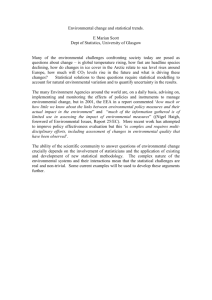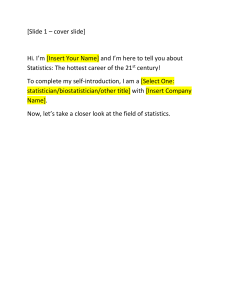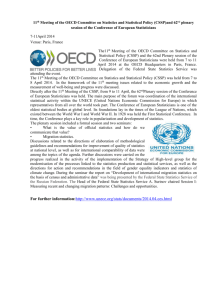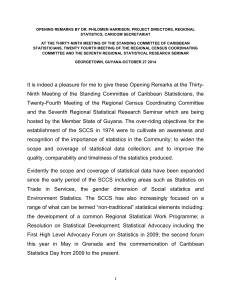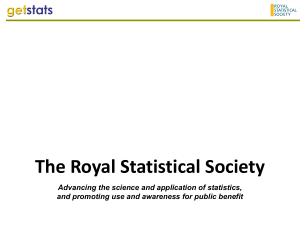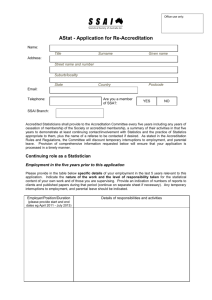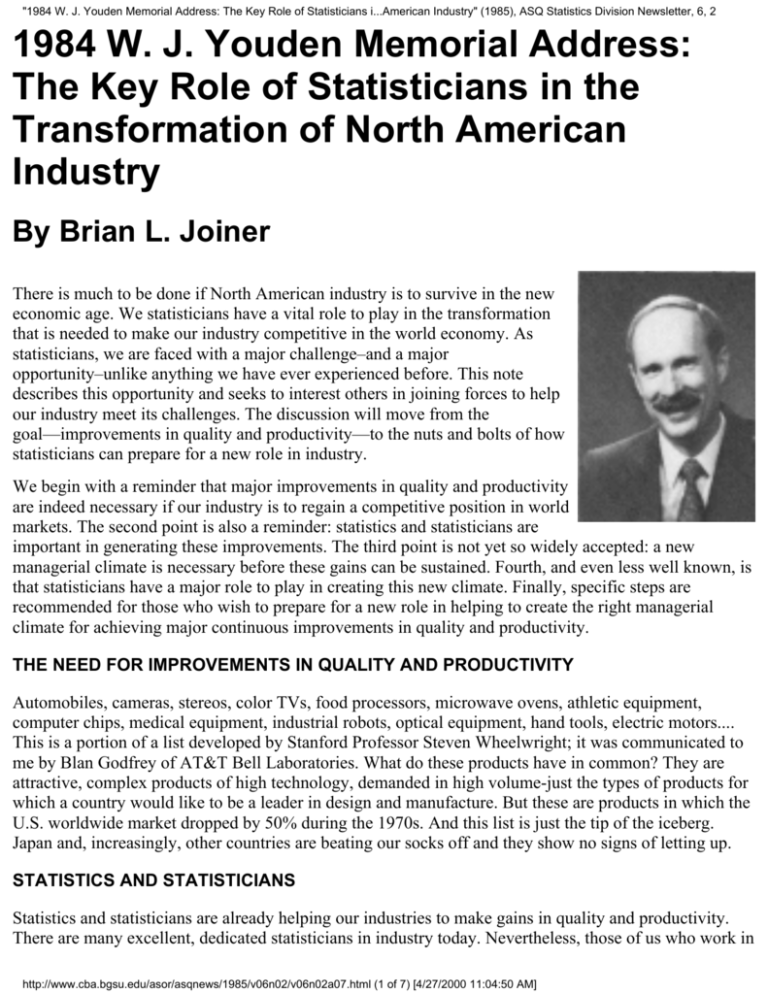
"1984 W. J. Youden Memorial Address: The Key Role of Statisticians i...American Industry" (1985), ASQ Statistics Division Newsletter, 6, 2
1984 W. J. Youden Memorial Address:
The Key Role of Statisticians in the
Transformation of North American
Industry
By Brian L. Joiner
There is much to be done if North American industry is to survive in the new
economic age. We statisticians have a vital role to play in the transformation
that is needed to make our industry competitive in the world economy. As
statisticians, we are faced with a major challenge–and a major
opportunity–unlike anything we have ever experienced before. This note
describes this opportunity and seeks to interest others in joining forces to help
our industry meet its challenges. The discussion will move from the
goal—improvements in quality and productivity—to the nuts and bolts of how
statisticians can prepare for a new role in industry.
We begin with a reminder that major improvements in quality and productivity
are indeed necessary if our industry is to regain a competitive position in world
markets. The second point is also a reminder: statistics and statisticians are
important in generating these improvements. The third point is not yet so widely accepted: a new
managerial climate is necessary before these gains can be sustained. Fourth, and even less well known, is
that statisticians have a major role to play in creating this new climate. Finally, specific steps are
recommended for those who wish to prepare for a new role in helping to create the right managerial
climate for achieving major continuous improvements in quality and productivity.
THE NEED FOR IMPROVEMENTS IN QUALITY AND PRODUCTIVITY
Automobiles, cameras, stereos, color TVs, food processors, microwave ovens, athletic equipment,
computer chips, medical equipment, industrial robots, optical equipment, hand tools, electric motors....
This is a portion of a list developed by Stanford Professor Steven Wheelwright; it was communicated to
me by Blan Godfrey of AT&T Bell Laboratories. What do these products have in common? They are
attractive, complex products of high technology, demanded in high volume-just the types of products for
which a country would like to be a leader in design and manufacture. But these are products in which the
U.S. worldwide market dropped by 50% during the 1970s. And this list is just the tip of the iceberg.
Japan and, increasingly, other countries are beating our socks off and they show no signs of letting up.
STATISTICS AND STATISTICIANS
Statistics and statisticians are already helping our industries to make gains in quality and productivity.
There are many excellent, dedicated statisticians in industry today. Nevertheless, those of us who work in
http://www.cba.bgsu.edu/asor/asqnews/1985/v06n02/v06n02a07.html (1 of 7) [4/27/2000 11:04:50 AM]
"1984 W. J. Youden Memorial Address: The Key Role of Statisticians i...American Industry" (1985), ASQ Statistics Division Newsletter, 6, 2
and with industry know that our effectiveness is related to the managerial climate in which we work; we
know we could accomplish much, much more in a more favorable climate. This brings me to my major
point: the need for a managerial climate in which major gains in quality and productivity become the
norm.
NEW MANAGERIAL CLIMATE
Managerial climate is the secret to Japan's success. Not robots, not tax policies, not cultural differences.
But what managerial climate is best, and why? An article in the Wall Street Journal for April 29,1983,
illustrates what the "new climate" is all about. RCA built a TV plant in Memphis in 1966, but shut it
down five years later after a series of wildcat strikes, union-authorized strikes, apparent product
sabotage, and layoffs that reduced the payroll from 4200 workers to 1600. Then Sharp of Japan moved
in, to salvage the plant and the reputation of the Memphis workforce. During the past four years, this
Japanese-managed plant has rolled out a million color TVs and a million microwave ovens. Productivity
is high; defect levels are very low. Sharp accomplished this with American workers, American
components, and a serious recession-and without layoffs or loss of profitability. What is their secret? It
has three parts: (i) obsession with quality, (ii) achieving a feeling among employees that they are one big
family, and (iii) identifying and correcting problems by means of data, not opinion or emotion. These
principles are best illustrated by a triangle, which connotes integrity—wholeness—and a synergy among
the parts.
Q:.; .1 ! i r.
Scientific
It pigrpach
Aii Onc
Team
An Obsession with Quality
Let me tell a story to illustrate what I mean by an obsession with quality. One company I work with had
acquired a very large number of parts (434,000, to be exact) from a supplier before they experienced
their first failure with that part. It was a "minor" part, costing only 11 cents. They notified the supplier,
and the supplier came to inspect the failed part and the circumstances of the failure. The part proved to be
defective, so the supplier changed their process. The company subsequently purchased over three million
of these parts with only one more failure. Now I ask you, do you think this supplier was under American
or Japanese management? Another part used by another company experienced an 8.5% failure rate. The
supplier of that part wanted to know why the company was complaining; the 8.5% failure rate was better
than the industry average. You guessed. That supplier was American-managed!
Scientific Approach: Focus on Processes
The key to improved quality is improved processes. Quality is improved through improvement in
process, not by inspection. This recalls the 85/15 rule of Juran and Deming, which says that at least 85%
of problems are system problems, and less than 15% are due to workers. (Deming now says that over
http://www.cba.bgsu.edu/asor/asqnews/1985/v06n02/v06n02a07.html (2 of 7) [4/27/2000 11:04:50 AM]
"1984 W. J. Youden Memorial Address: The Key Role of Statisticians i...American Industry" (1985), ASQ Statistics Division Newsletter, 6, 2
94% of problems appear to be system-related.)
Processes make things work. Thousands of processes need improvement, including things not ordinarily
thought of as processes, such as the hiring and training of workers. We must study these processes and
find out how to improve them. The scientific approach, data-based decisions, and teamwork are key to
improving all these processes. This kind of emphasis on processes is one of the principal things Japanese
managers have achieved, but American managers typically have not.
All One Team
This is absolutely necessary. Lacking team spirit, employees can, through passive resistance, impede the
best efforts at quality improvement. With it, everyone seeks improvement, everyone gains from
improvement, and teamwork becomes pervasive.
Here is an example of how one American-managed company improved its productivity and at the same
time fostered the team spirit among its workers. This company employed 20 workers in a metal finishing
area. These workers, their managers, and technical support people set to work to improve productivity.
As a result the number of workers required dropped first to 11 and then to 7. Now the usual response of
American management would be to lay off the "surplus" workers. This company, however, taught them
new skills, moved them into new jobs, and recognized their contributions to the company. What would
have happened if they had been laid off, instead?
Another success story (William Serrin, New York Times) is about a Warwick TV plant that moved from
the Midwest to the Sun Belt in order to be competitive. But that didn't work either, and after a few years
the plant was sold to Sanyo, a Japanese company. Sanyo kept the same work force and now turns out
excellent TV sets at a high level of productivity. The secret? A new managerial climate, with
authoritarianism de-emphasized. A 12-year worker says, "We are a family."
The triumph of Japanese management is being repeated all over North America. The companies are not
perfect, but they are highly successful. The February 2, 1984, issue of USA Today reports that 476
Japanese-owned companies now employ 82,900 American workers in the manufacture of everything
from balloons to automobiles. It can be done in North America. It is being done.
The triangle, which has quality, teamwork, and the scientific approach at its apices, summarizes the
major requirements of the new managerial climate needed for our industry to regain its competitive
position in world markets. You may recognize that this triangle is also a condensed form of Dr. W.
Edwards Deming's 14 Points for Management. Now I acknowledge that not everyone agrees with
Deming. But I must tell you that after several years of focused study and hard work in this area, I have
become increasingly convinced that while Crosby, Juran, and others have many good ideas, Deming goes
much further in understanding the deep underlying problems facing North American industry.
Some statisticians think Deming has gone too far and is too confrontive with top management. I will not
argue about the packaging of his message; it might be improved. But I believe the message itself is right
on target, and I ask you to suspend judgment on Deming and open your mind to the possibility that he
may be right. Let us review his 14 Points for Management, which apply to organizations of all types and
all sizes-not only to entire companies, but to their parts.
1. Create constancy of purpose toward improvement of product and service.
2. Adopt the new philosophy; we are in a new economic age.
http://www.cba.bgsu.edu/asor/asqnews/1985/v06n02/v06n02a07.html (3 of 7) [4/27/2000 11:04:50 AM]
"1984 W. J. Youden Memorial Address: The Key Role of Statisticians i...American Industry" (1985), ASQ Statistics Division Newsletter, 6, 2
3.
4.
5.
6.
7.
8.
9.
10.
11.
12.
13.
14.
Cease dependence on inspection to achieve quality.
End the practice of awarding business on the basis of initial cost.
Improve constantly and forever every activity.
Institute training and education on the job, including management.
Institute supervision.
Drive out fear.
Break down barriers between departments.
Eliminate slogans and exhortations.
Eliminate work standards that prescribe numerical quotas.
Remove barriers that rob workers of their right to pride of workmanship.
Institute a vigorous program of education and retraining.
Put everybody in the company to work in teams to accomplish the transformation.
Trust of Management-Absence of Fear
Statisticians can help bring this about by demonstrating to managers that at least 85% of problems are
system-related, not worker-related. When we urge and help managers to improve processes throughout
the company, they come to understand the 85/15 rule. These process improvements in turn help convince
workers that management really cares about the organization and thus cares about their collective
survival.
We can also eliminate the making of demands inconsistent with process capabilities. We can help
identify and eliminate inadequate materials or training. Workers will no longer take the brunt of the
blame when processes fail. Thus we may ultimately be able to convince management not to terminate
workers when productivity gains are made, or lay them off when the economy dips downward. We may
also be able to help to convince management and labor that gains in productivity lead to more jobs and
greater job security, not to fewer jobs and less security.
Some statisticians may say we can do well enough without the change in managerial climate. But I do
not believe it. Let me cite an example. One manager I know got really turned on when he learned about
statistics. He studied processes and improved them. He used Pareto charts, control charts, and design of
experiments. He isolated the causes of problems and eliminated them. His workers thought he was super,
because he worked with them and helped them get rid of many of the hassles that had plagued them in
their jobs.
Then, he was relieved of his responsibility because his manager and other managers did not understand
the 85/15 rule. When he pointed to problems outside his own area, the other managers felt he was
pointing to them-where in reality, he was pointing out the problems in the system.
You may encounter similar problems. Your work may often be stopped at departmental barriers. You
may be asked to work on problems that you know are nor the most important and urgent problems of the
company. Do you work in a place where other employees, from top to bottom of your organization,
actively seek your advice to help them improve quality and productivity? You are useful to your
organization now, but you could be much, much more useful.
http://www.cba.bgsu.edu/asor/asqnews/1985/v06n02/v06n02a07.html (4 of 7) [4/27/2000 11:04:50 AM]
"1984 W. J. Youden Memorial Address: The Key Role of Statisticians i...American Industry" (1985), ASQ Statistics Division Newsletter, 6, 2
ROLE OF STATISTICIANS IN CREATING THE NEW MANAGERIAL CLIMATE
I have briefly described the new managerial climate and why it is important. I hope you agree with me
that it is needed. The next question is, is there anything we statisticians can do to help create the new
climate? The surprising answer is yes. There are things that we statisticians are among the best prepared
to do. Dr. Deming told me that for three years before I believed him. He said, "Nothing less is required
than the transformation of the American style of management-and you (statisticians) must show
management how to create that climate."
I could not see it. I could not see why I or other statisticians should be involved in the creation of a new
climate. I could see why statisticians would benefit from the change—that part was relatively easy. But
what did I know that would help with the transformation of the American style of management? Only in
the past year have I come to understand what Deming means and I would like to share with you my new
understanding of his message. I do not expect to convince everyone to become involved in the
transformation of management. That is not necessary. But some of us do need to be involved.
It will not be easy. The transformation of management is not a role that we have been well prepared for.
It is a much broader and more ambitious role, which requires new skills that most of us have not tended
to develop. But let us look at a few aspects of the new management philosophy and note what
contribution statisticians can make toward their implementation.
Everyone Seeking Improvements in Quality and Productivity
Statisticians can help implement this by teaching managers how to focus on processes rather than on
blaming individuals. American managers do not normally think in terms of processes, especially not
processes like: the process of recruiting well qualified employees, the process of training first-line
supervisors, the process of introducing new products. Teaching managers how to study and improve such
processes helps them understand why everyone else should also be studying processes and seeking
improvements. Many statisticians find it natural to think in terms of processes; we know how to gather
and interpret data from processes to help improve them.
Statisticians can also help speed up improvements, and the success of these efforts tends to build
confidence and esprit de corps. We tend to seek out causes, not jump to solutions. More often than others
we ask why? How do you know? As a result, projects to improve processes are usually completed much
faster and with much better results when statisticians are involved.
For example, in one company a production line often went down. Why? Study found that the ink
jet-labeling machine failed frequently. Why? The major cause turned out to be fluctuating pressure in the
airlines. The machine failed whenever the pressure dropped below 66 psi. The study team recommended
purchase of local compressors to supply uniform pressure. But they should have asked why one more
time: they should have asked why the pressure fluctuated, because it turned out that other machines also
had problems when the pressure dropped. Statisticians tend to persist longer in asking why and thus tend
to help teams achieve better results.
Eliminating Barriers Between Departments
Statisticians can help to quantify current process capabilities. Only when these capabilities are truly
known will others be able to place realistic expectations on them. Unfortunately, management knows
http://www.cba.bgsu.edu/asor/asqnews/1985/v06n02/v06n02a07.html (5 of 7) [4/27/2000 11:04:50 AM]
"1984 W. J. Youden Memorial Address: The Key Role of Statisticians i...American Industry" (1985), ASQ Statistics Division Newsletter, 6, 2
today that if they put enough pressure on one point that group will generally come through. They often
interpret this to mean that increased pressure is the best way to get results. But they need to learn how
this pressure distorts the system and interferes with overall quality and productivity.
We can show how understanding processes helps provide ways for data-based communication of
departmental needs. We can help to eliminate finger-pointing and get down to the facts. "In God we trust.
All others must bring data." Or, "Facts often kill a good argument."
HOW STATISTICIANS CAN PREPARE FOR THIS CHALLENGE
Statisticians have three types of special knowledge. We are uniquely well qualified (i) to figure out what
data to collect and how, (ii) to interpret data in the face of variation, and (iii) to coach others in the proper
use of the scientific approach.
The first and second types of knowledge, figuring out what data to collect and interpreting the data in the
face of variation, are obvious. But the third point may be surprising. We often think that other people
approach problem solving and process improvement in the same way we do, even though most statistical
consultants would admit that one of the most valuable contributions they make to an investigation is the
use of a logical, data-oriented approach. As Cochran and Cox (1957) remind us, perhaps the major
contribution a statistician can make in the planning stages of an investigation does not involve statistical
theory at all, but simply forcing the investigator to explain clearly why he is doing the study, why he
chose the proposed method and why he thinks the completed study will answer the questions it was
intended to answer. Although we statisticians do not usually think of our role in this way, the role is a
natural one, because we as a group are most likely to ask why? How do you know? And, how will you
know?
But to be maximally useful in the transformation, we must further educate ourselves. We must learn the
new philosophy in depth. We must thoroughly understand the Quality-Teamwork-Scientific triangle and
the teachings of W. Edwards Deming, Juran, and others. We must understand current American
management style, its strengths and weaknesses. Finally, we must prepare to venture far beyond our
familiar statistical territory to learn new skills—interpersonal skills, team-building skills, how to plan for
change, and how organizations work.
In conclusion, here are a few specific recommendations for action:
● Locate one or more partners who specialize in the new skills and who complement your strengths.
● Educate yourself and others as to what must be done and why. Listen to and study Deming, Juran,
and others.
● Seek to change roles. Think bigger, more strategically—more like the president of the company or
the chairman of the board. Help get a team organized to work on a key project. Help to obtain
major, highly visible gains in quality and productivity. Get higher and higher level managers on
board with respect to understanding the new philosophy.
Then when enough of us have done these things, we will be in a position to make major contributions
toward the survival of North American industry.
SUMMARY
http://www.cba.bgsu.edu/asor/asqnews/1985/v06n02/v06n02a07.html (6 of 7) [4/27/2000 11:04:50 AM]
"1984 W. J. Youden Memorial Address: The Key Role of Statisticians i...American Industry" (1985), ASQ Statistics Division Newsletter, 6, 2
1. Major changes in management are needed if we are to become and remain competitive with the
Japanese.
2. Statisticians have a vital role to play in the creation of the new managerial climate.
3. Some of us need to expand our view of what we can contribute to our organizations.
4. We need to develop new skills and new ways of thinking about our roles.
5. Then we will be ready to achieve and sustain major gains in quality and productivity.
References
CALONIUS, L. E. (1983). "Factory Magic." The Wall Street Journal, April 29.
COCHRAN, W. G., and COX, G. M. (1957). Experimental Designs, 2nd ed. John Wiley & Sons, New
York.
SERRIN, W. (1983). "Japanese Clearly Doing Something Right in U.S. Plant." The New York Times (in
San Diego Mercury News), Nov. 9.
USA Today (1984). "Japan's Goods Roll In: East Comes to the West." Feb. 2.
Copyright © 1984 by joiner Associates Inc.
All rights reserved.
Dr. Brian L. Joiner currently operates his own consulting firm which provides software products as well
as consulting and training designed to improve the quality and productivity of manufacturers, service
companies, educational institutions, and government agencies. He may be contacted in care of Joiner
Associates, Inc., 732 North Midvale Blvd., P.O. Box 5445, Madison, Wisconsin, 53705.
http://www.cba.bgsu.edu/asor/asqnews/1985/v06n02/v06n02a07.html (7 of 7) [4/27/2000 11:04:50 AM]

